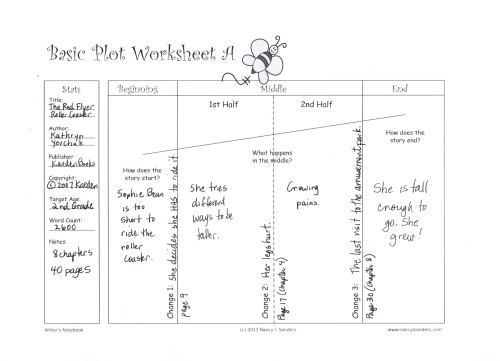Challenge: Write a Chapter Book in 1 Month–Plot
If you’re following along with the CHABOOCHA challenge this month and also writing an early chapter book using THE RED FLYER ROLLER COASTER as your mentor text, scheduled on the calendar for today is “Chart plot of mentor text”
and brainstorm plot ideas.
As a working writer under contracts to write various books from magazine stories to picture books to chapter books, I always start first by using my Basic Plot Worksheet A.
And when I’m following a mentor text, I like to first chart the plot of my mentor text before I tackle my own work in progress.
You can see the information I filled in along the left column of the chart above.
Then, for the plot elements I first had to ask myself what the main story plot is for THE RED FLYER ROLLER COASTER? That led me to the main story problem which is that Sophie Bean is too short to ride the roller coaster.
After I identified that, it took a little digging around to discover the 3 key changes that take place in the story:
Change 1: Takes us from the beginning of the story where we see the main story problem and starts the middle of the story where now we see Sophie Bean is determined to do something to solve this problem.
Change 2: This is the turning point of the whole story where suddenly Sophie Bean has a new problem to deal with…her legs hurt.
Change 3: Suddenly Sophie Bean finds out it’s the last day to go to the amusement park this summer and thus the last chance she’ll get to ride the roller coaster!
And then we learn the conclusion to the story: Her legs hurt because they were growing pains and she grew tall enough to go on the roller coaster. Yay!
One of the nice things about writing a book for this reading level is that the plot is pretty straightforward. There is a clear beginning, middle, and end. The problem is presented in the first couple of paragraphs of the story and it all wraps up nicely at the end…even with a fun surprise by having grandma ride with her for her very first ride on the roller coaster.
As you’re preparing to plot your own story tomorrow, keep all these basic elements in mind. For a book at this readability level you don’t even need a subplot. Just keep it nice and simple. It’s a great way to get our feet wet writing these chapter books, don’t you think?
So as you’re brainstorming plot ideas today, just think of these basic story elements:
A) What is your main story problem that the main character struggles with? This is how your story should start.
B) What is the first change that happens where your main character sets off on her journey to solve the big problem?
C) What is the turning point, the second change that happens to lead your character toward the ending of the story and the solution to her problem?
D) What is the third change that happens to your character to lead her to the end of the story.
E) How will the story end and how will your main character solve the main story problem?
Having these elements in your head will help you as you start to write your story next week. It will be your road map to success. Brainstorming ideas today will give you material to help you plot your own story on the BASIC PLOT WORKSHEET A tomorrow.
To download your own copy of my Basic Plot Worksheet A, please visit the site of my writing buddies, Writing According to Humphrey and Friends. Scroll down to the CHARTS AND WORKSHEETS TO GET ORGANIZED FOR SUCCESS and click on the link to download and print your own copy of the BASIC PLOT WORKSHEET A. You can use it tomorrow to plot the structure of your own chapter book so you’ll be all ready to start writing next Monday!
Filed under: Beginning Readers, Chapter Books

Nancy I. Sanders's Blog
- Nancy I. Sanders's profile
- 76 followers




